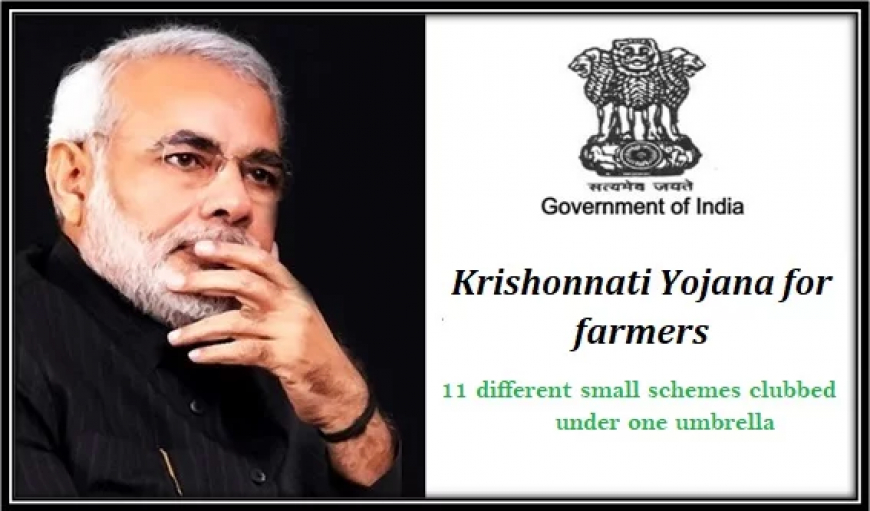Krishonnati Yojana 2023
Green Revolution in Agriculture Sector by CCEA

Krishonnati Yojana 2023
Green Revolution in Agriculture Sector by CCEA
The Cabinet Committee on Economic Affairs (CCEA) has approved the Green Revolution Krishonnati Yojana under the Umbrella Scheme for farmers. Now this scheme will continue to run continuously for more than 12 years from the period 2017-18 to 2018-19. This meeting was presided over by Prime Minister Narendra Modi who approved the scheme with the central government's share of Rs 33,269.976 crore. There are 11 schemes and missions under this scheme alone. Its primary objective is the overall development of agriculture and its related sectors. This umbrella scheme is for the welfare of farmers and its first step is “to double the income of farmers by 2022”.
The central government will also focus on scientific methods to increase the income of farmers along with productivity, productive capacity and better returns. The government will also continue to spend a total of Rs 33,269.976 crore for this scheme for 3 consecutive financial years of 2017-18, 2018-19 and 2019-2020.
Features of Krishonnati Yojana – Green Revolution
This scheme has been specially designed for the development of agriculture sector. Green Revolution Scheme-2018 is made up of 11 different schemes, which are as follows.
List of schemes under Krishonnati Yojana
Mission for Integrated Development of Horticulture
Rs 7533.04 crore
To encourage overall development of horticulture sector, to increase production, to enhance nutritional security in farm houses along with economic support.
National Food Security Mission
Rs 6893.38 crore
Increase in production of rice, wheat, pulses, coarse grains and commercial crops. This will happen when the area will be expanded by identifying the districts and the productive capacity will be increased. This will also include the work of enhancing the ability to restore soil fertility and productivity at the level of individual farms. This will increase the availability of vegetable oil and reduce the import of edible oil.
National Mission for Sustainable Agriculture (NMSA)
Rs 3980.82 crore
To promote sustainable agriculture and focus on agro-ecology including integrated farming, effective soil health management and resource conservative technologies.
Submission on Agriculture Extension
Rs 2961.26 crore
Institutional level program planning and implementation mechanism to achieve food and nutritional security and socio-economic empowerment of farmers. For cooperation and effective linkage among various stock holders. To promote innovative use of electronic/print media, inter-personal communication and ICT tools etc. to support HRD interventions.
Sub-Mission Own Seed and Planting Material
Rs 920.6 crore
Increasing production of quality seeds, increasing SRR, strengthening seed multiplication chain, promoting new technology in seed production, processing, testing. These activities will strengthen the infrastructure for seed production, storage, certification and quality.
Sub-Mission Own Seed and Planting Material
Rs 920.6 crore
Increasing production of quality seeds, increasing SRR, strengthening seed multiplication chain, promoting new technology in seed production, processing, testing. These activities will strengthen the infrastructure for seed production, storage, certification and quality.
Sub-Mission on Agricultural Mechanism (SMAM)
Rs 3250 crore
To take farm mechanization to small and marginal farmers so that they can get adequate power supply, To promote custom hiring centers to reduce the high cost of individual ownership, For high-tech and high value farm equipment and performance To ensure testing
Submission on Plant Protection and Plan Quarantine (SMPPQ)
1022.67 crores
To reduce crop damage caused by insect pest diseases, weeds, nematodes and rodents. The primary objectives are to reach Indian agricultural products to the global market and adopt new strategies for the protection of plants.
Integrated Scheme on Agriculture Census, Economics and Statistics (ISACES)
Rs 730.58 crore
Its objectives are to undertake agricultural census, study crop cultivation costs, research on agro-economic problems, improve the system of agricultural statistics, generate information on the status and production of crops and hierarchy from sowing to harvesting.
Integrated Scheme on Agricultural Cooperation (ISAC)
Rs 1902.636 crore
To provide financial assistance to improve and enhance the economic condition of cooperatives - for cooperative development in marketing, processing, storage, computerization and weak links of the programme.
Integrated Scheme on Agricultural Marketing (ISAM)
Rs 3863.93 crore
Grading, quality certification, establishment of central marketing information network, market integration through common online platform.
National e-Governance Plan (NeGP-A)
Rs 211.06 crore
The scheme is designed to enhance and integrate ICT initiatives in existing state and central governments to enhance service policy, reach and impact of extension services across various programmes, and to provide information and services to farmers.
The above schemes have been made to focus on suitable infrastructure, to reduce production costs and to increase agricultural products. The central government was already running all these schemes for many years. In 2017-18, the government has decided to combine all these schemes which are Green Revolution-Krishonnati Yojana.
Other decisions taken in CCEA meeting
The Central Government launched the Pradhan Mantri Jan-Vikas Karyakram. Revamped Multi Sectoral Development Programme.
CCEA also approved that Pradhan Mantri Swasthya Suraksha Yojana will be continued for the financial year till 2020 to provide good health care to the people. This will also include issues of construction of new AIIMS and development of government medical colleges. The Central Government has also doubled the investment limit for senior citizens under Pradhan Mantri Vaya Vandan Yojana (PMVVY) from Rs 7.5 lakh to Rs 15 lakh and has now extended the PMVVY 2018 scheme from 4 May 2018 to 31 March 2020. Under this scheme, citizens above 60 years of age will be given a monthly pension of up to Rs 10,000.
| Name | ‘Krishonnati Yojana’ |
| Who launched this scheme? | central government |
| total plans | 11 plans |
| Duration | by the year 2020 |
| Which sector is this scheme related to? | agricultural sector |
| Budget | 33,26 9.9 76 Ten million |







